Guitars
|
ESP LTD EC-10
-F. Davies
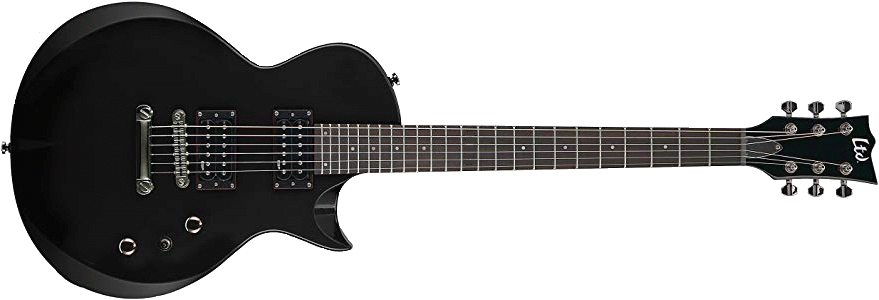
Once again having gone a while without a solidbody electric guitar, I choose to go with a bargain basement priced one, the ESP LTD EC-10. Nor real complaints for this Paul sort of design with the exception of one of the upper frets needed to be tapped down a bit with a tiny hammer and polished as it was catching the high E string if bent too far. Otherwise, it played well right out of the box.
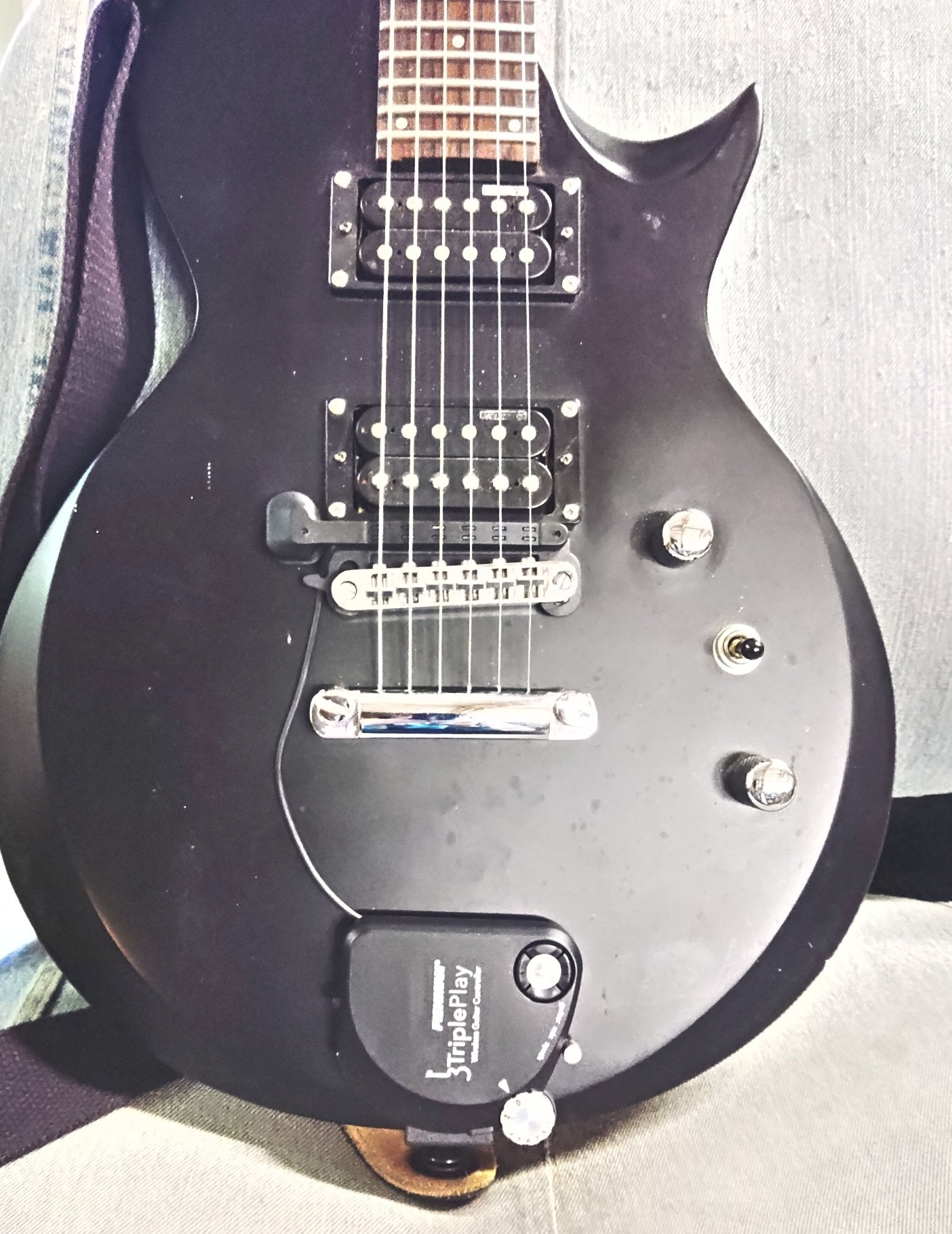
It has a maple neck with a thin U shaped contour. Scale length is the same as on the SG I later got, 24.75 inches. The fingerboard is made of some kind of engineered hardwood according to ESP, and I have no clue what that means, nor anything negative to say about it ...yet. Its radius is 13.78 inches.
Again, I do like that it has 24 frets and XJ (extra jumbo) fret wires. Tuners are LTD, and seem to work well. Neck pickup is an ESP Designed LH-100N and the bridge pickup is their LH-100B.
There's nothing fancy about this instrument with just volume, tone and selector switch. The quality is good and it might be one of the better choices for a beginner on a budget under $200. After purchasing the SG, I've added a MIDI pickup to this one, intent on just using it in that way.
|
Cozart 12 string
-F. Davies
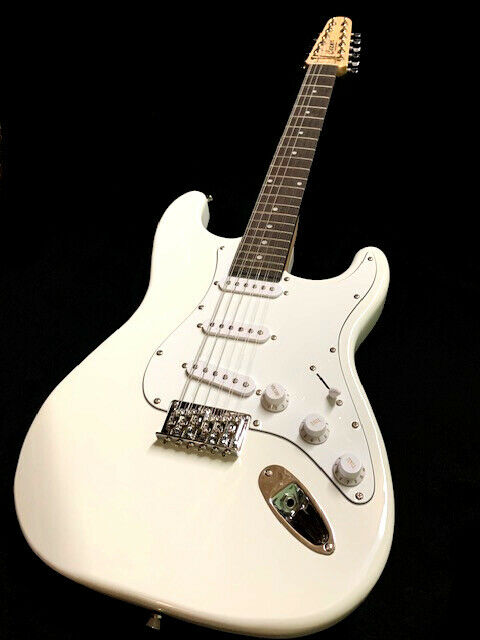
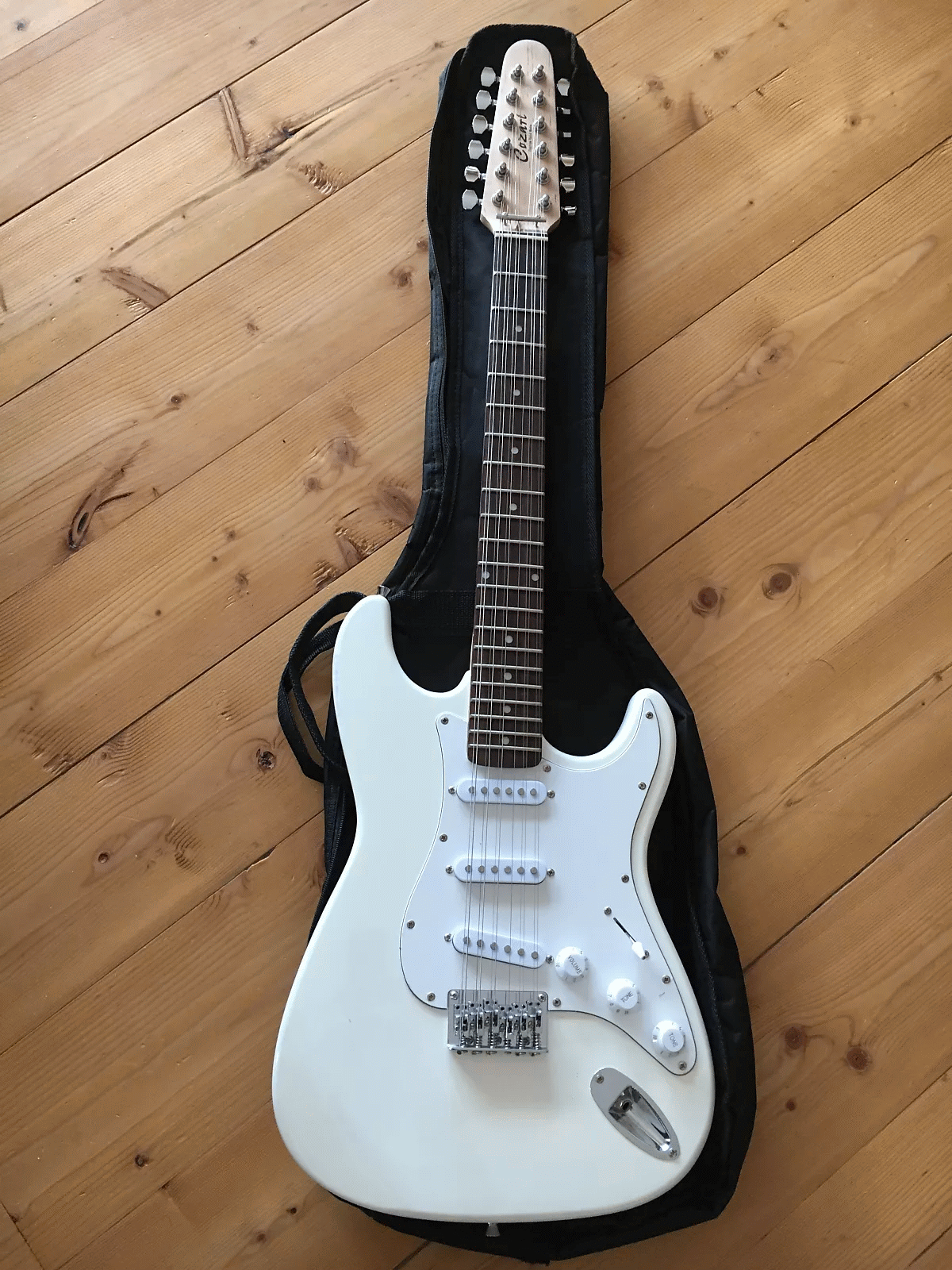
Having a 6 string electric guitar, I wanted to also have a 12 string. I've owned one before long ago and there simply is nothing to compare to the unique sound of a 12 string. Still on a budget, I found this one on Ebay going for a mere $125, made in China
I was surprised when I first picked it up as it is the lightest weight guitar I think I've ever touched. Despite weighing almost nothing, it otherwise is quite playable, and strongly resembles a Fender Stratocaster.
No complaints from me, but comments from others would suggest replacing the pickups, electronics, and tuners to really make the most of it.
It has three pickups, a volume control, and two tone controls in addition to a 5-way selector switch. String length is 25.5 inches and the nut is 2 inches wide. Mine is white, the perfect color for looking like a Strat if you ask me.
|
D'Angelico Premier EXL-1
-F. Davies
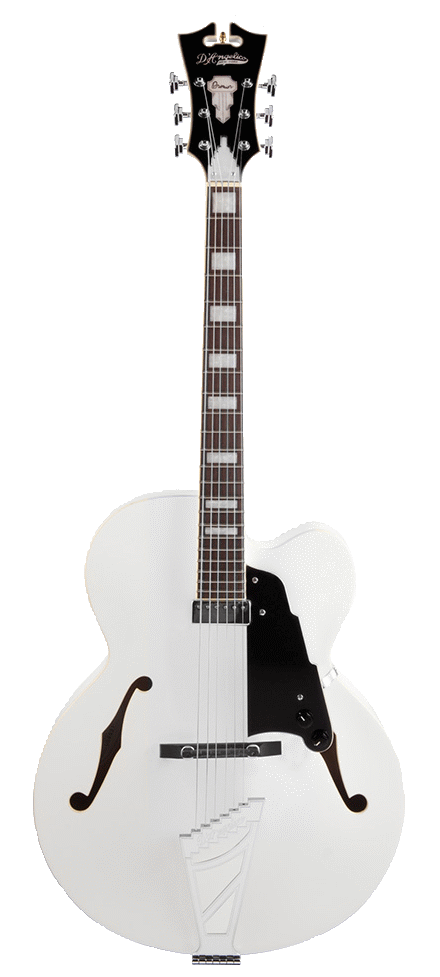

My first guitar was an archtop I got in some three way horse trade my little brother made. I think I lost my vac-u-form in the process. I can't remember the brand, possibly a Harmony, but I foolishly painted it white with brown and green ivy stems and leaves. I packed it around everywhere with me and still had it going on into college. Many decades later I can't remember what became of it, but longed for another archtop until just a few years back.
The brand of archtops which were the rage in New York back in the 1930's were those made by John D'Angelico in Manhattan's Little Italy. While it would be cool to have one of his original handmade instruments, I'm afraid they are severly out of the range of my budget.
Luckily they are still being made, although turned out in a factory instead of being handmade as they once were. I purchased a Premier EXL-1 modeled after his original ones, with a single pickup and without the center block connecting back to top found on modern archtops to reduce feedback. I like that the pickup floats above the top and the controls are on the pickguard also held up from the top so the top is free to vibrate fully, something not found in most other electric archtops.
Nut Width is an inch and 11/16ths. Medium jumbo fretwire. And a scale length of 25 1/2 inches. The fingerboard radius is 14 inches with a C-shaped neck. The body is 3 inches deep and 17 inches wide. It has a Duncan-designed floating Mini-Humbucker near the neck. Tuners are Rotomatic Stairstep.
I appreciate this instrument for its authenticity in reproducing the sound made by the original ones back in the 30's. I haven't noticed any feedback problems or issues with the quality. It's my "go-to" guitar for playing jazz.
|
Epiphone SG Standard '61 Maestro Vibrola
-F. Davies


In the distant past I've owned an Ibanez 59-er, a close copy of the Les Paul and the first electric guitar I bought, and later a somewhat used Gibson Les Paul. I loved both of them, but sold the first one, desperate for money as usual and the Gibson was stolen by a girlfriend who traded it for something I won't mention here. ...No, I was not a happy camper about it.
The SG had always interested me due to it being like the Paul but with a double cut-away, giving better access to the upper frets. Not long ago I ran into one a gal had purchased and decided to sell after realizing there was more to playing a guitar than she had thought. It was several years old and in mint condition. And it was red, a color that just seemed somehow proper for an SG. While not a Gibson, it plays well after putting on new strings, adjusting the neck and giving it some attention to the height of the frets with a file.
The neck on this SG has a slim taper profile with 22 medium jumbo frets and a scale length of 24.75 inches. It's 1.692 inches wide at the nut and the Indian Laurel fingerboard has a radius of 12 inches. It has a LockTone Tune-O-Matic bridge and a Maestro Vibrola tailpiece. The tuning machines are Epiphone Deluxe Vintage machine heads with an 18:1 ratio. The body is made out of mahogany.
Electronics include ProBucker 2 for the neck pickup and ProBucker 3 for the bridge pickup. It has 2 volume and 2 tone controls, (CTS pots) with a 3-way pickup selector toggle switch. My Vibrola model has a whammy bar, something I have yet to really explore in my playing but wanted to investigate.
I guess a lot of famous folks have played Epiphone guitars from The Beatles on through to home town girl Carrie Brownstein of Sleater-Kinney who recorded most of her music with an Epiphone SG, something which speaks volumes about their quality. I've added strap locks to mine so the quality won't be diminished by it dropping on the floor.
|
Dallas Strunk Classical Guitar
-F. Davies
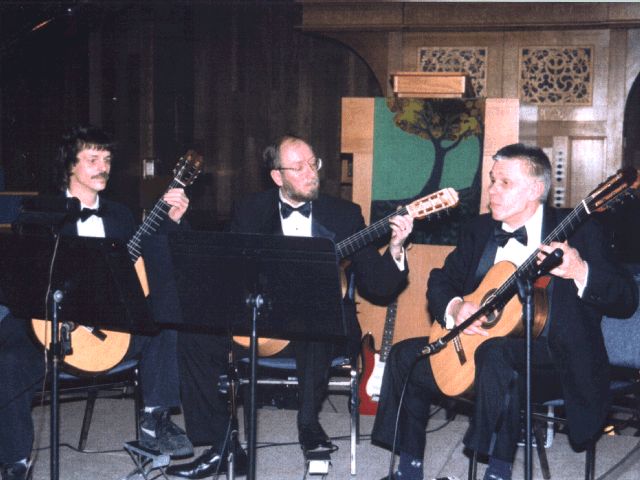 So, long story here... While I've owned a few guitars, I've been drawn to the classical guitar more than the others since I first started playing. I bought my first one, a Takamine, while still in Alaska after fishing aboard a purse seiner for the summer. I took it on the plane with me and later to Central Washington University where I studied calculus and worked as a computer programmer. I sold it a couple years later to pay tuition and soon deeply regretted it.
So, long story here... While I've owned a few guitars, I've been drawn to the classical guitar more than the others since I first started playing. I bought my first one, a Takamine, while still in Alaska after fishing aboard a purse seiner for the summer. I took it on the plane with me and later to Central Washington University where I studied calculus and worked as a computer programmer. I sold it a couple years later to pay tuition and soon deeply regretted it.
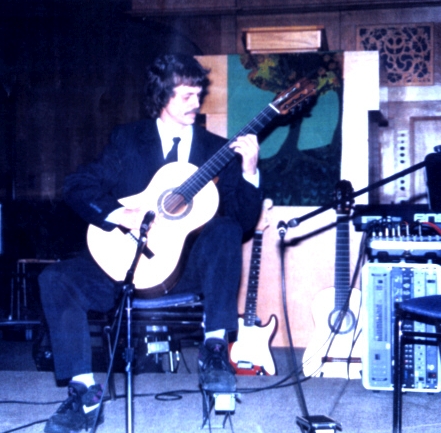
A decade and a half later I plunked down a C-note and picked up a Harmony classical (likely made in the 70's) at a pawn shop in Tacoma, ...which I still have to this day. It's pretty beat up, as I scraped the top to reveal the real wood under the orange varnish and glued the neck back on after sliding down a hill with it in my hands.
Shortly after getting it, perhaps a year later I called around asking who was the best classical guitar instructor and then made an appointment to meet Rick Riley, at his Virtuoso Studios and began getting serious about playing.
Rick introduced me to Dallas Strunk of Idaho (now deceased) and I wound up buying his serial number 002 instrument, the first he made with a spruce top. Of interest was that the tuners Dallas used were made by the late John Gilbert, a well known luthier who had once been the Chief Tooling Engineer for the Hewlett-Packard Company. The sound was nothing short of incredible. Rick too played a Strunk as did Gordon (center) in Rick's Vivaldi Trio pictured to the left.
|
J. Marcario Classique 45 Guitar
-F. Davies
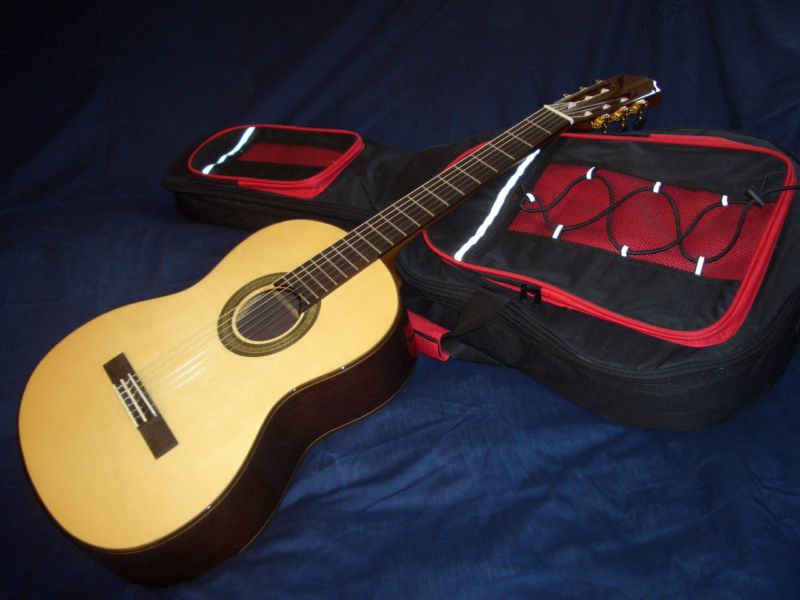

This is currently my best classical guitar. I'd rate it in the category of being a reasonable instrument for performing at recitals, but not quite a professional grade instrument. While my Strunk had a better tone (yes, I foolishly sold it decades ago, ...when will I learn) the neck on this one is superior in its modest taper. When it comes to classical guitars, how they sound is everything, and this one sounds okay.
These instruments are from France. As I understand it, the brand hires out to local luthiers who actually make the instruments. So it's handmade but by some unknown frog desperate to make an instrument meeting their standards so he can get paid and make another. From all that I can tell there are few out there for sale and I have not run into another one exactly like mine.
It also looks beautiful. The top is spruce, even with a tight grain, Back and sides are rosewood, with a hint of a tiger stripe. Headstock, binding, rosette etc. all nicely done. The nut measures 2.09 inches wide and the string length is 25.5 inches, the same as my archtop D'Angelico. There are no issues with fret buzz but the action which I like is a bit high for some who play lighter. The tuners look to be made by Shaller, but I'm not certain and could be Chinese knock-offs.
|
Ibanez PF15ECE
-F. Davies

It seems strange to say that only after playing the guitar for close to sixty years have I finally come around to getting an acoustic guitar (not counting the archtop of my youth.) I like the sound, and at times was a bit jealous of friends who owned and played them. The sound simply has that special something lending itself to strumming chords and singing along. A bright metallic sound we are all familiar with I'm sure.
As fate would have it, I had a gift card from over a year back burning a hole in my pocket and when I asked an online sales rep about it, I learned I could use it right over the phone. He also bent over backwards to make the sale by lowering the total down to match my card. They typically sell for around $230, still a bargain at that price.
This is a dreadnought with a cutaway and is electric as well. It has an under saddle pickup with their AEQ-2T preamp and built-in tuner. The body is 15 7/8 inches wide and 5 inches deep. Scale length is 25.6 inches and the nut is 1.65 inches wide. Fretboard radius is 9.85 inches. Nothing really fancy about it but it does have a spruce top, something I look for in a guitar. I must say it's very nice for the money and would recommend it to any shopping in that price range. |
|


|



 Please Log in. Not a member? Click to join!
Please Log in. Not a member? Click to join!






 So, long story here... While I've owned a few guitars, I've been drawn to the classical guitar more than the others since I first started playing. I bought my first one, a Takamine, while still in Alaska after fishing aboard a purse seiner for the summer. I took it on the plane with me and later to Central Washington University where I studied calculus and worked as a computer programmer. I sold it a couple years later to pay tuition and soon deeply regretted it.
So, long story here... While I've owned a few guitars, I've been drawn to the classical guitar more than the others since I first started playing. I bought my first one, a Takamine, while still in Alaska after fishing aboard a purse seiner for the summer. I took it on the plane with me and later to Central Washington University where I studied calculus and worked as a computer programmer. I sold it a couple years later to pay tuition and soon deeply regretted it.


